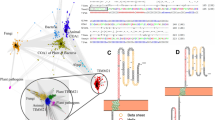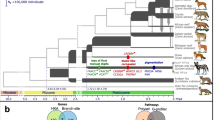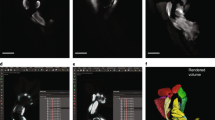Abstract
Powerful masticatory muscles are found in most primates, including chimpanzees and gorillas, and were part of a prominent adaptation of Australopithecus and Paranthropus, extinct genera of the family Hominidae1,2. In contrast, masticatory muscles are considerably smaller in both modern and fossil members of Homo. The evolving hominid masticatory apparatus—traceable to a Late Miocene, chimpanzee-like morphology3—shifted towards a pattern of gracilization nearly simultaneously with accelerated encephalization in early Homo4. Here, we show that the gene encoding the predominant myosin heavy chain (MYH) expressed in these muscles was inactivated by a frameshifting mutation after the lineages leading to humans and chimpanzees diverged. Loss of this protein isoform is associated with marked size reductions in individual muscle fibres and entire masticatory muscles. Using the coding sequence for the myosin rod domains as a molecular clock, we estimate that this mutation appeared approximately 2.4 million years ago, predating the appearance of modern human body size5 and emigration of Homo from Africa6. This represents the first proteomic distinction between humans and chimpanzees that can be correlated with a traceable anatomic imprint in the fossil record.
This is a preview of subscription content, access via your institution
Access options
Subscribe to this journal
Receive 51 print issues and online access
$199.00 per year
only $3.90 per issue
Buy this article
- Purchase on Springer Link
- Instant access to full article PDF
Prices may be subject to local taxes which are calculated during checkout




Similar content being viewed by others
References
Rak, Y. The Australopithecine Face (Academic, New York, 1983)
Aiello, L. & Dean, C. An Introduction to Human Evolutionary Anatomy (Academic, New York, 1998)
White, T. D., Suwa, G., Simpson, S. & Asfaw, B. Jaws and teeth of Australopithecus afarensis from Maka, Middle Awash, Ethiopia. Am. J. Phys. Anthropol. 111, 45–68 (2000)
Tobias, P. V. The Skulls, Endocasts, and Teeth of Homo habilis (University Press, Cambridge, 1991)
Walker, A. & Leakey, R. (eds) The Nariokotome Homo erectus skeleton (Harvard Univ. Press, Cambridge, Massachusetts, 1993)
Vekua, A. et al. A new skull of early Homo from Dmanisi, Georgia. Science 297, 85–89 (2002)
Acakpo-Satchivi, L. et al. Growth and muscle defects in mice lacking adult myosin heavy chain genes. J. Cell Biol. 139, 1219–1229 (1997)
Allen, D. L., Harrison, B. C., Sartorius, C., Byrnes, W. C. & Leinwand, L. A. Mutation of the IIB myosin heavy chain gene results in muscle fiber loss and compensatory hypertrophy. Am. J. Physiol. Cell Physiol. 280, C637–C645 (2001)
Martinsson, T. et al. Autosomal dominant myopathy: missense mutation (Glu-706 → Lys) in the myosin heavy chain IIa gene. Proc. Natl Acad. Sci. USA 97, 14614–14619 (2000)
Korfage, J. A. & Van Eijden, T. M. Myosin heavy chain composition in human masticatory muscles by immunohistochemistry and gel electrophoresis. J. Histochem. Cytochem. 51, 113–119 (2003)
McPherron, A. C., Lawler, A. M. & Lee, S. J. Regulation of skeletal muscle mass in mice by a new TGF-β superfamily member. Nature 387, 83–90 (1997)
Hamrick, M. W., McPherron, A. C., Lovejoy, C. O. & Hudson, J. Femoral morphology and cross-sectional geometry of adult myostatin-deficient mice. Bone 27, 343–349 (2000)
Hohl, T. H. Masticatory muscle transposition in primates: effects on craniofacial growth. J. Maxillofac. Surg. 11, 149–156 (1983)
Brennan, M. & Antonyshyn, O. The effects of temporalis muscle manipulation on skull growth: an experimental study. Plast. Reconstr. Surg. 97, 13–24 (1996)
Warren, S. M., Brunet, L. J., Harland, R. M., Economides, A. N. & Longaker, M. T. The BMP antagonist noggin regulates cranial suture fusion. Nature 422, 625–629 (2003)
Messier, W. & Stewart, C. B. Episodic adaptive evolution of primate lysozymes. Nature 385, 151–154 (1997)
Chou, H. H. et al. Inactivation of CMP-N-acetylneuraminic acid hydroxylase occurred prior to brain expansion during human evolution. Proc. Natl Acad. Sci. USA 99, 11736–11741 (2002)
Brunet, M. et al. A new hominid from the Upper Miocene of Chad, Central Africa. Nature 418, 145–151 (2002)
Haile-Selassie, Y. Late Miocene hominids from the Middle Awash, Ethiopia. Nature 412, 178–181 (2001)
Leakey, M. G., Feibel, C. S., McDougall, I., Ward, C. & Walker, A. New specimens and confirmation of an early age for Australopithecus anamensis. Nature 393, 62–66 (1998)
Lockwood, C. A., Kimbel, W. H. & Johanson, D. C. Temporal trends and metric variation in the mandibles and dentition of Australopithecus afarensis. J. Hum. Evol. 39, 23–55 (2000)
Asfaw, B. et al. Australopithecus garhi: a new species of early hominid from Ethiopia. Science 284, 629–635 (1999)
Uyeda, T. Q. P., Ruppel, K. M. & Spudich, J. A. Enzymatic activities correlate with chimaeric substitutions at the actin-binding face of myosin. Nature 368, 567–569 (1994)
Desjardins, P., Burkman, J., Shrager, J., Allmond, L. & Stedman, H. Evolutionary implications of three novel members of the human sarcomeric myosin heavy chain gene family. Mol. Biol. Evol. 19, 375–393 (2002)
Swofford, D. PAUP*. Phylogenetic Analysis Using Parsimony (*and Other Methods) (Sinauer Associates, Sunderland, Massachusetts, 1998)
Yang, Z. PAML: a program package for phylogenetic analysis by maximum likelihood. CABIOS 13, 555–556 (1997)
Kumar, S., Tamura, K., Jakobsen, I. B. & Nei, M. MEGA2: molecular evolutionary genetics analysis software. Bioinformatics 17, 1244–1245 (2001)
Bamman, M. M., Clarke, M. S., Talmadge, R. J. & Feeback, D. L. Enhanced protein electrophoresis technique for separating human skeletal muscle myosin heavy chain isoforms. Electrophoresis 20, 466–468 (1999)
Levine, S., Kaiser, L., Leferovich, J. & Tikunov, B. Cellular adaptations in the diaphragm in chronic obstructive pulmonary disease. N. Engl. J. Med. 337, 1799–1806 (1997)
MacCoss, M. J., Wu, C. C. & Yates, J. R. Probability-based validation of protein identifications using a modified SEQUEST algorithm. Anal. Chem. 74, 5593–5599 (2002)
Acknowledgements
We thank K. Brayman, N. Mirza, M. Ruckenstein and the University of Washington National Primate Research Center (Seattle) for providing access to the biopsy material used in this study; N. Gilmore of the Philadelphia Academy of Natural Sciences for access to specimens for photography; L. Joseph, D. Fonseca, R. McCourt and W. Ewens for assistance with the bioinformatic analysis; and P. Dodson, L. Whitaker, A. Kelly and S. Bartlett for advance reading of the manuscript. We also thank colleagues in the University of Pennsylvania Genomics Institute Bioinformatics Core, and Wistar Institute Proteomics Facility for their assistance. This work was supported in part by grants to H.H.S. from the NIH (NIAMS and NINDS), MDA, AFM, VA and the Genzyme Corporation.
Author information
Authors and Affiliations
Corresponding author
Ethics declarations
Competing interests
The authors declare that they have no competing financial interests.
Supplementary information
Supplementary data
Distance matrices (XLS 24 kb)
Rights and permissions
About this article
Cite this article
Stedman, H., Kozyak, B., Nelson, A. et al. Myosin gene mutation correlates with anatomical changes in the human lineage. Nature 428, 415–418 (2004). https://doi.org/10.1038/nature02358
Received:
Accepted:
Issue Date:
DOI: https://doi.org/10.1038/nature02358
This article is cited by
-
Few dental indices in modern Bulgarian population from southern Bulgaria
Journal of Physiological Anthropology (2023)
-
The reciprocal jaw-muscle reflexes elicited by anterior- and back-tooth-contacts—a perspective to explain the control of the masticatory muscles
BDJ Open (2020)
-
Molecular fossils “pseudogenes” as functional signature in biological system
Genes & Genomics (2020)
-
The ancient sarcomeric myosins found in specialized muscles
Skeletal Muscle (2019)
-
Gene Encoding a Novel Enzyme of LDH2/MDH2 Family is Lost in Plant and Animal Genomes During Transition to Land
Journal of Molecular Evolution (2019)
Comments
By submitting a comment you agree to abide by our Terms and Community Guidelines. If you find something abusive or that does not comply with our terms or guidelines please flag it as inappropriate.



